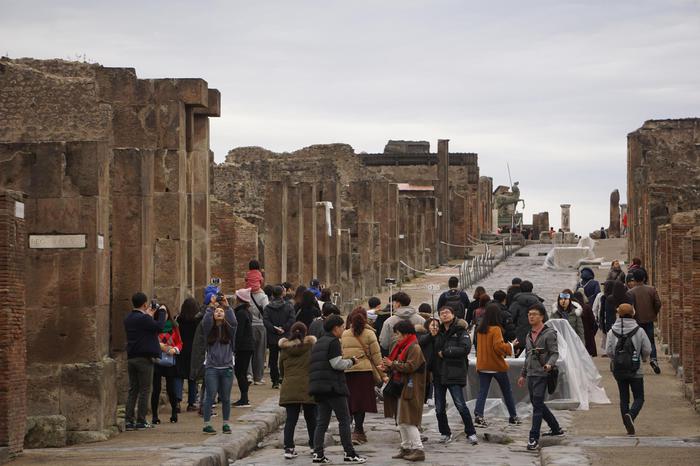For an Englishman, his house is his castle, but for Charles Jencks, an Englishman's house is his abstruse cosmic symbolism. The number 5 of Landsdowne Walk, located in Notting Hill, a neighborhood that is apparently always in fashion, has no main door but a portal, in the great sense of the word. In any case, Jencks, who died last October, was not entirely English, although he lived in London since 1965, the year he left the Oxford School of Design. He was born in 1939 in Baltimore (United States), of composing father. Patricio, kind, charming and we must recognize that a little arrogant on account of his position, education and wealth (his late wife, Maggie Keswick, belonged to the family that invented Hong Kong), it has never occurred to anyone to say: " Come on, Charlie. It's not a portal, it's a damn front door! "
This great disseminator of postmodernism belongs to the long list of Anglo-American artists and intellectuals who settled in London, and which includes the painter JM Whistler, the writer Henry James and the poet TS Eliot. Jencks' thinking can sometimes be as ethereal as Nocturno , Whistler's painting. His prose, as cumbersome as James's. And his thoughts and references, as arcane as those of Eliot.
On May 4, 2018, Jencks's house was declared a Grade One Building , which is not bad for something that, in reality, is a cosmic speculation project. Because Grado Uno means that we are facing an officially recognized work of architecture; before a significant element of national heritage; before a project, according to officials, as important as the Parliament or the Tower of London. Insurance?
Before describing the house of Charles Jencks, I must speak of Charles himself and his mentor, Reyner Banham (1922-1988), the most influential English architecture historian since the German Nikolaus Pevsner. Banham worked on The Architectural Review during the most influential period of this historic magazine, after which he taught at the Bartlett School of Architecture at the University of London, in which Jencks was his doctoral student.
Banham was a grumpy contestant, whose populous apostolic beard and his hobby of going everywhere by bicycle betrayed a messianic personality. He was present at the invention of Pop Art in 1956, extolled everyday life in his writings, coined the term "brutalism" and cultivated with great success the image of a great guy. But he was also an excellent academic, a meticulous researcher and an original thinker. His theory and design in the first machine age , published in 1960, remains the best work on heroic modernism. That's why I think that, both in work and in thought, Charlie Jencks wanted to surpass his teacher.
According to officials, we are facing a building as important as the Tower of London or the British Parliament. Insurance?
Jencks published his first book, Architecture 2000: Predictions and Methods , in 1971. Before studying architecture, he had studied literature and was greatly influenced by the most vogue critical theories. For his book, he borrows ideas from semiotics and anthropologist Claude Lévi-Strauss. Find the distinction between significant (for example, "surface") and meaning (that is, "content") fascinating, for example, and often mention it. Little did it matter that Roland Barthes, the great wizard of semiotics, went deeper and deeper into the darkness every time he tried to apply the semiotic method: Jencks had already drunk a lot of that heady spring of intellectual imposture.
In 1972 he published the brilliant Adhoc-ism, an irreverent update of the object trouvé . The following year, he published his doctoral thesis, which he titled Modern Movements in Architecture . The plural "movements" is significant, with which Jencks meant that modern architecture was not a coherent whole, but a fluid and fractal assembly. Banham had overseen the thesis but then, privately, he regretted granting Jencks the doctorate, since it gave him a license to spread the confusion in the solemn halls of architectural history.
Although Architecture 2000 was published five years after Robert Venturi's transcendental complexity and contradiction , Jencks made no mention of postmodernism. He did it later, in The language of postmodern architecture (1977), a book that cemented his reputation and that, already in its eighth edition, has become a strange event: a bestseller in the history of architecture.
The work showed that Jencks was able to achieve rhetorical genius. One of his claims, that "the death of modern architecture" happened exactly on July 15, 1972, when Pruitt-Igoe (the famous hive-housing complex that Minoru Yamasaki had built in Missouri 20 years earlier) was dynamited, was It has become one of those quotes that you never forget.
Perhaps out of jealousy, the most recalcitrant architecture historians do not respect Jencks. They say he is not an academic, but a publicist, a hound that is dedicated to sniffing new movements. And it is true that it does not show a very serious interest in history or construction technology. What matters to Jencks is all that has to do with decoding. After all, what does cosmogenesis have to do with a house? On the other hand, recent history has also not treated some of the postmodern architects Jencks defended so loudly, such as Michael Graves, Charles Moore, James Stirling and Hans Hollein. Forty years later, none of them has become a great figure of enduring reputation.
Jencks conceived his house as a controversial manifesto in favor of postmodernism. He wanted to show us what "symbolic design" was
But let's go to Jencks Castle, which he calls Thematic House, the Thematic House. It is not that living machine that Le Corbusier formulated, but an esoteric Jencksian thesis, decorated with medium density laminate that is aging regularly. It began to be built in 1979 and, although Jencks states that he made more than a thousand drawings, he had the help of architect Terry Farrell (since Jencks has no professional title). For a while, Farrell was the most visible, and audible, postmodern architect in England. But the failure of the TV-am channel, whose headquarters was responsible for projecting, established a direct connection between postmodernism and commercial incompetence that has never completely disappeared.
Jencks conceived his Thematic House as a controversial manifesto in favor of postmodernism, at a time when he was worried that his idolized movement was losing his understanding of the ornament. He said that the trend had degenerated into a set of " kitsch sconces," and added that his intention was to "show what symbolic design is." And wow he has.
From the street, the window profiles of the Thematic House can be perceived as people or dogs, although it is not easy to say why that is a good thing. The portal is a "cosmic oval". Once the threshold is crossed, a mirror room is reached, a demonstration of self-referential narcissism. The ground floor is organized around a central spiral staircase. One of the adjacent rooms is called Winter and was co-designed by Michael Graves: the station is represented with Chinese rocks on wooden plinths and a bust of Hephaestus, inspired by the features of the frowning sculptor Eduardo Paolozzi. In Summer there is a mural by Allen Jones that drinks from The Dance of the Music of Time , by Poussin (you can see it in the Wallace Collection in London). And where you think you are seeing a semicircle with seats in front of the window, you are wrong: it is not a semicircle with seats in front of a window, but a "sundial." Because, as you see, time passes.
Very concerned about the difference between cosmic time and cultural time, the movement of the spheres or the preparation of a curry, Jencks chose "late summer" as the theme of his cooking. The stairs leading to the bedroom have 52 steps and seven divisions each. Scholars believe that it may be a reference to the solar year. In Jencks' office, the shelves are shaped like buildings.
"This house is the most intense since Sir John Soane's," said architect Alejandro Aravena. Which is a compliment to Jencks
I have visited the Thematic House several times and it never ceases to amaze me. But, at least in my case, astonishment can become panic and an urgent desire to escape. In a historical moment in which Alejandro Aravena, with his ideas on the social role of housing, is the most important architect in the profession, I don't understand what Jencks is about.
Aravena himself surrenders before him: "This house is the most intense since Sir John Soane's," he said, referring to the strange and incomparable cornucopia of architectural remains that the great neoclassical architect gathered in what is now his London museum . Being honest, this is a comparison that flatters Jencks and questions Soane.
Is the Thematic House the work of a rich and charming nut or is it serious architecture? Jencks can't help us answer this question. He once gave a lecture at the Chelsea Flower Festival. I know because I was there. The theme was "Waves", since at that time he was more interested in geomorphology than buildings. He spoke cordially for about 40 minutes, in which he did not express a single understandable idea. As a monologuist it was brilliant. As a rational narrator of garden design, it was so disconcerting that people looked for air and looked at the clock.
Jencks once said that the history of architecture is "a series of internal debates against his professional idiocy." I would like to start another debate. Be careful in an era of LGBT activism with saying things like this, but isn't the Thematic House actually transvestite architecture? Is it not all arranged and without where to go? Is it just an eccentric luxury? A collection of kitsch sconces? Personally, I am very happy that Charles Jencks has built the Thematic House because it is framed within an excellent tradition of English eccentricity, to which the Chambers Pagoda, in Kew, or the Beckford Tower, in Bath also belong. And I'm even more glad that nobody has prepared to copy it. Or maybe it is that I simply lack cosmic awareness.







